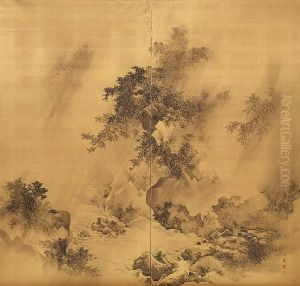Nomura Bunkyo Paintings
Nomura Bunkyo was a Japanese painter known for his work during the late Edo period. Born in Edo (present-day Tokyo) in 1814, Bunkyo was part of a culturally rich period in Japanese history. His given name was Nomura Yoshikuni, and he later took the pseudonym 'Bunkyo' for his artistic endeavors. Bunkyo was primarily recognized for his contributions to the nanga (Southern painting) school of Japanese painting, which was characterized by its emphasis on Chinese literati painting styles.
Bunkyo's artistic journey was influenced by the changing times in which he lived. The Edo period was a time of relative peace and stability in Japan, allowing arts and culture to flourish. However, it was also a time when Japan was gradually opening up to Western influences after more than two centuries of self-imposed isolation under the Tokugawa shogunate. This exposure to the West began to affect Japanese art, including the work of painters like Bunkyo.
Throughout his career, Bunkyo was known for his landscapes, flower-and-bird paintings, and for incorporating Chinese themes and techniques into his work. He was skilled in capturing the essence of his subjects with a sense of simplicity and spontaneity, which were hallmarks of the nanga style. Bunkyo's paintings often reflected a scholarly reclusiveness and a yearning for the natural world, common themes in Chinese literati art that were adopted by Japanese nanga painters.
Despite the fact that Bunkyo lived through a period of great transition, including the decline of the Tokugawa shogunate and the beginning of the Meiji Restoration in 1868, he remained dedicated to the traditional nanga style. He continued to paint and contribute to the Japanese art scene until his death in 1878.
Bunkyo's work has been appreciated for its delicate brushwork and its reflection of the artist's personal intellect and spirit. His contributions to the nanga movement have secured him a place in the history of Japanese art. Today, his paintings can be found in various art collections and museums, serving as a testament to the enduring nature of the nanga tradition and its practitioners.
